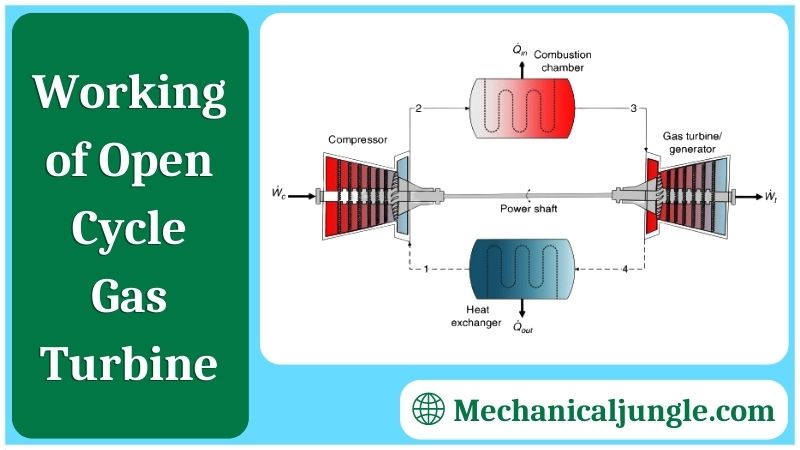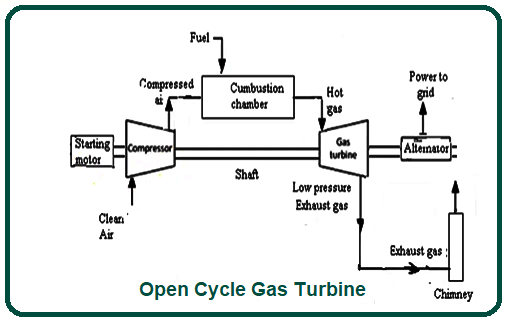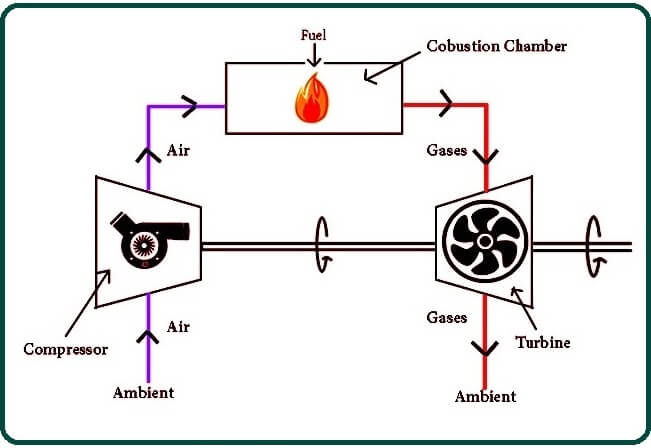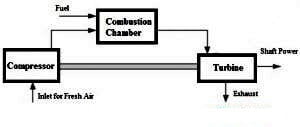
What Is the Open Cycle Gas Turbine?

Open-cycle gas turbines can be defined as the turbine plant that is fired using liquid fuel to rotate the generator to produce electricity. Residual heat can be worn into the environment at 550o Celsius.
The generator and turbine are attached to reduce noise levels and occupy an approximate area such as 75 m X 25 m for each unit. The height of the exhaust stacks can be approximately 30 meters through the intake structure at 20 m height.
The major components used in open cycle gas turbines include a compressor, combustion chamber, turbine, control, and start-up. A compressor uses air from the environment and lowers it to several stages within the compressor.
Liquid fuel can be supplied to combustion chambers, where the chamber contains compressed air. After that, the mixture of both air & fuel can be ignited to produce gas with high velocity.
This gas can be supplied by using the blades of the turbine blades to turn the shaft which is connected to the rotor within the generator. Rotations of the rotor can be done within a stator to generate electricity. After that, this power can be supplied through a network of high voltage wherever required.
Gas turbines can be classified based on three main phenomena such as the process of combustion, the working of the material path, and the action of the combustion gases within the turbine.
Working of Open Cycle Gas Turbine:

#1. Isentropic Compression
From 1 to 2, air enters the compressor. After entering the compressors, the air is compressed by the compressors. As the air is compressed by the compressors, its volumes decrease from V1 to V2, and the pressure increases from P1 to P2.
It is assumed that the entropy remains constants, no heat is transferred during this process, but the temperature will increase due to compressions from T1 to T2.
#2. Isobaric Expansion
From 2 to 3, the compressed air from the compressor will enter the burner. In the burner, the temperature will increase, & the volume will also increase from V2 to V3 due to expansion due to heating.
This process will be a continuous pressure process. The fuel will enter the chamber from above and mix with the air before burning. After burning, the temperature will rise and expand.
In the P – V diagram, the pressure (P) will remain constant, & the volume will increase from V2 to V3. In the T-S diagram, the temperatures (T) will increase from T2 to T3, and the entropy from S2 to S3 will also increase.
#3. Isentropic Expansion
From 3 to 4, the hot air from the burner or combustion chamber will reach the turbine, and the air inside the turbine will expand, and some work will be done due to the expansion.
This process will be an isentropic process, & no heat will be transferred during this process. In this process, the volume will increase due to expansion, and the pressure will decrease. This process will be the opposite of the 1 to 2 process.
In the P-V diagram, the volume (V) will increase from V3 to V4, and the pressure (P) will decrease from P3 to P4. In the T-S diagram, the temperature (T) will decrease from T3 to T4, and the entropy (S) will remain constant.
#4. Gas Released into the Atmosphere
From 3 to 4, the air from the turbine will be released into the atmosphere. Also, air will be drawn from the atmosphere to the compressor, and the whole cycle will repeat again.
In the P – V diagram, the pressure (P) will remain constant, and the volume (V) will decrease from V3 to V4. In the T-S diagram, temperature (T) will decrease from T3 to T4, and Entropy (S) will also decrease from S3 to S4.
Components of Open Cycle Gas Turbine:
#1. Compressor
The compressor is used to compress the air. Most common axial flow compressors are used in an open cycle gas turbine.
#2. Burner or Combustion Chamber
After passing through the compressor, air enters the burner or A. Combustion chamber. In this burner, a constant pressure process will occur. The pressure will be constant, but the temperature will rise.
#3. Turbine
The isentropic process will also be done in the turbine. When the hot gas from the combustion chamber reaches the turbine, it will expand into the turbine. As the gas expands, some work will be done by the gas, and then it will escape from the system.
Working Principle of Open Cycle Gas Turbine:
The open cycle gas turbine diagrams are shown below. The working principle of OCGT is when fresh air enters the compressor at ambient temperature, where the temperature rises both as well as the temperature.
High-force air can enter the combustion chamber, where liquid fuel can move at a constant force. High-temperature gas can enter the turbine, where it increases the ambient force and generates electricity.

The main features of an open-cycle gas turbine include the following.
- It is applicable for combined cycles.
- Open cycle gas turbine efficiencies are high thermal up to 44%.
- Long life and reliability are high.
- It is also used in electric power as well as in the propulsion of aircraft.
- The start-up time for the turbine is as fast as 2 minutes compared to the steam-propulsion system because it takes four hours.
- The back work ratio is up to 50% higher than the low percentage within the steam power plant.
Advantages of Open Cycle Gas Turbine:
The benefits of open-cycle gas turbines include the following.
- This gas turbine is not working, so it depends on the pressure of the atmosphere, so any type of force can be used to improve specific plant production. Once the pressure is applied to the turbines, the size of the components used in them can be reduced.
- The gas used in these turbines can be of any type. For example, the combination of helium and helium and carbon dioxide can give high efficiency, so it is used in nuclear plants.
- Simplicity, low weight, and cost
- Turbine blades are not contaminated through combustion products.
- Turbine regulation is very simple.
- Low thermal stresses may exist at different loads due to constant temperature.
Disadvantages of Open Cycle Gas Turbine:
Disadvantages of open-cycle gas turbines include the following.
- An exchanger with fast heat is required whenever high forces are applied to the input of the compressor.
- The results of poor heat transfer and poor combustion efficiency are mainly due to the heat exchanger based on the indirect type.
- In this type of turbine, the combustion chamber is more efficient and is applicable to a larger volume of air.
- They are sensitive.
- The part-load efficiency of these turbines is poor.
Applications of Open Cycle Gas Turbine:
Applications of the open-cycle gas turbines include the following.
- Generally, gas turbines are used to provide aviation power, especially for jet propulsion.
- Electric power generation.
- Some industrial processes.
- Industries.
- Propulsion of marine, automotive, and locomotives.
- They are used in the application of mechanical drives.
FAQs (Frequently Asked Questions) that you can include in your article about open cycle gas turbines:
What Is an Open Cycle Gas Turbine?
An open cycle gas turbine is a type of turbine plant that uses liquid fuel to generate electricity by rotating a generator.
How Does an Open Cycle Gas Turbine Work?
The turbine works by compressing ambient air, mixing it with fuel in a combustion chamber to generate high-temperature gas, expanding this gas through a turbine to produce mechanical work, which is then converted into electricity.
What Are the Main Components of an Open Cycle Gas Turbine?
The main components include a compressor, combustion chamber, turbine, generator, and auxiliary systems for control and start-up.
What Are the Advantages of Open Cycle Gas Turbines?
Advantages include high efficiency (up to 44%), fast start-up time (as little as 2 minutes), versatility in fuel types, and suitability for combined cycle applications.
What Are the Disadvantages of Open Cycle Gas Turbines?
Disadvantages include poor part-load efficiency, sensitivity to ambient conditions, and the requirement for efficient heat exchange systems.
Where Are Open Cycle Gas Turbines Used?
They are used in electric power generation, aviation propulsion, industrial processes, and mechanical drives for marine, automotive, and locomotive applications.
What Makes Open Cycle Gas Turbines Suitable for Aviation?
Their high power-to-weight ratio and efficiency make them ideal for jet propulsion systems, where weight and fuel efficiency are critical factors.
How Do Open Cycle Gas Turbines Compare to Other Types of Power Generation?
They offer faster start-up times and higher thermal efficiencies compared to steam power plants, but they may have lower efficiency at part loads.
What Advancements Are Being Made in Open Cycle Gas Turbine Technology?
Advances focus on improving efficiency, reducing emissions, enhancing reliability, and expanding fuel flexibility to include renewable and alternative fuels.
What Are the Future Prospects for Open Cycle Gas Turbines?
The future involves continued research into enhancing efficiency, reducing environmental impact, and integrating with renewable energy sources to support sustainable power generation.

